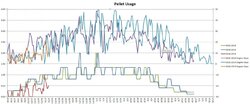However many pellets I add to the stove in the morning is the amount I burned the day before.How are you measuring pellets daily? Do you scoop out the remaining pellets each day and measure? Confused a bit..
Way to go by the way!!
Pellet Consumption Graph
- Thread starter TimfromMA
- Start date
-
Active since 1995, Hearth.com is THE place on the internet for free information and advice about wood stoves, pellet stoves and other energy saving equipment.
We strive to provide opinions, articles, discussions and history related to Hearth Products and in a more general sense, energy issues.
We promote the EFFICIENT, RESPONSIBLE, CLEAN and SAFE use of all fuels, whether renewable or fossil.



